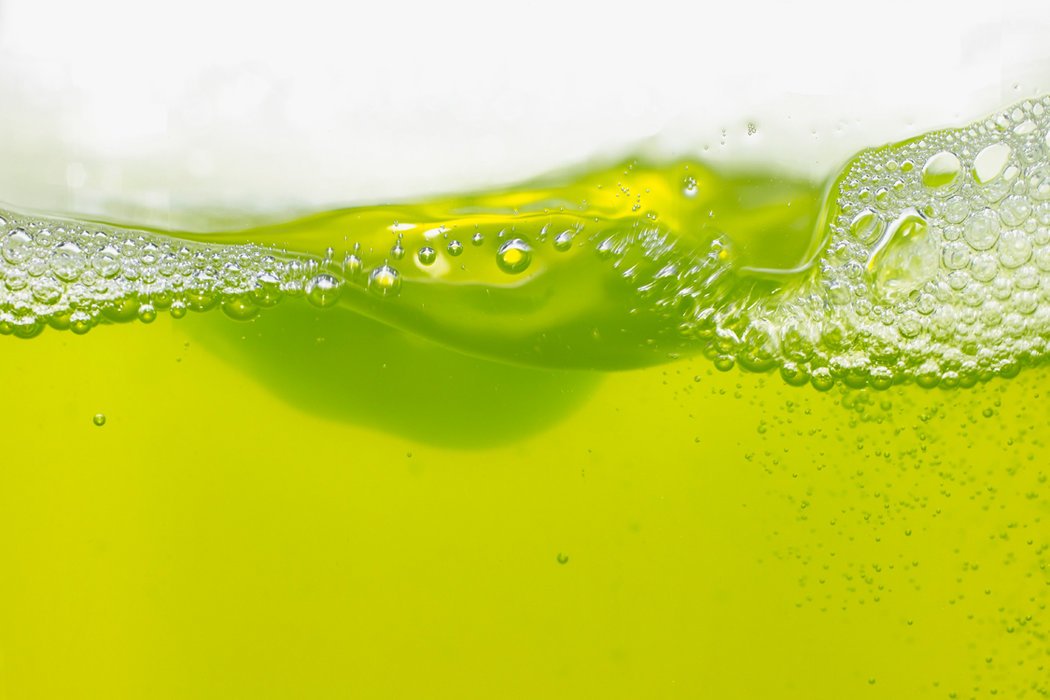|
The energy drink, as we know it, started in Japan. In the postwar period, amphetamines were very popular until laws were passed to curb their use in the 1950s. Then in 1962, a company called Taisho introduced Lipovitan D — a legal, energizing tonic sold in minibar-size bottles. By the 1980s, such vitamin-fortified, extra-caffeinated beverages were being regularly consumed by Japanese executives struggling to get ahead. One television ad showed Arnold Schwarzenegger bursting from a flagon like a juiced-up genie. Another had a hero in suit and tie, signing deals and making presentations as he raced around the world. “Can you fight for 24 hours a day?” he chanted with his chin upturned. “Businessman, businessman, Japanese businessman!”
如我们所知,能量饮料源自日本。在战后时期,安非他命(Amphetamines)曾经非常流行,直到20世纪50年代相关法律出台,它的使用受到约束。于是在1962年,一个叫做Taisho的公司推出了力保健 (Lipovitan D),这是一种合法的,能够补充能量的汽水饮料,它们封装在适合小酒柜大小的瓶子里出售。到了80年代,这种混合了维生素和额外咖啡因的饮料深受努力拼搏的日本企业管理者们欢迎。就好像一个电视广告中演的那样,阿诺德o施瓦辛格(Arnold Schwarzenegger)冲破一个细口瓶蹦了出来,如同一个充满了能量的妖怪。另一则广告中则展示了一个西装革履的英雄,他在全世界马不停蹄地签署协议和做演讲。“你能够全天24小时地保持斗志吗?”他下巴上扬,反复地说道。“商人,商人,日本商人!“
It took a while for this sort of stimulation in a can to catch on in America. There was cocaine in Coca-Cola at one point, but that didn’t last long. In 1949, a chemist from Chicago invented Dr. Enuf, a caffeinated soft drink made with vitamins. Early advertisements called his drink “the answer to a housewife’s prayer, the bosom companion of a tired farmer or businessman and a shift into high gear for young Johnny or Mary.” (Although it never sold very well, the beverage still exists.) In the 1980s, other soda brands tried in vain to muscle in on coffee’s turf: Jolt Cola promised “all the sugar and twice the caffeine”; Coke started pushing “Coca-Cola in the morning”; and Pepsi introduced the short-lived breakfast product “Pepsi A.M.”
这种封装在易拉罐中的兴奋剂过了好一段时间才被美国人所接受。可口可乐中曾经一度含有可卡因,但那并未持续很久。1949年,一个芝加哥化学家发明了“Dr.Enuf”,这是一种带有维生素的咖啡因软饮料。早期的广告称他这种饮料是“对于家庭主妇们祈求的回应,是疲惫的农夫和商人们的忠诚伴侣,能令年轻的约翰尼和玛丽全力以赴。”(虽然它从未热销,但依然在市场上生存了下来)。20世纪80年代,其它的汽水公司也徒劳地试图在咖啡的市场上分得一杯羹:焦特可乐(Jolt Cola)承诺“糖分一样,两倍的咖啡因含量”;可乐则开始大力宣传“早上来杯可口可乐”;百事也推出了短命的早餐产品“Pepsi A.M.”。

Meanwhile, Japanese energy drinks made their way from Asia to Europe. Dietrich Mateschitz, the international marketing director for an Austrian company that sold bathroom products, discovered the supercharging tonics while on a business trip to Bangkok. In 1984, he quit his job to partner up with the Thai manufacturer of a beverage made with caffeine and taurine called Krating Daeng, and three years later he debuted a carbonated version of the same in his home country under the Red Bull label.
与此同时,日本的能量饮料想方设法地从亚洲来到了欧洲。迪克o梅特舒兹(Dietrich Mateschitz)当时是澳大利亚一家浴室产品公司的国际市场总监,他在曼谷出差时发现了这种能够提供能量的饮料。1984年,他辞去了工作,与一家泰国公司合伙生产一种叫做“Krating Daeng”的含咖啡因和牛黄酸的饮料,三年后,他在家乡用“红牛”的品牌推出了这种饮料的碳酸版本。
Mateschitz brought his beverage to the United States in 1997, and the market for energy drinks took off. Annual growth remains in the double digits, says Gary Hemphill, director of research for the Beverage Marketing Corporation. Last year the category accounted for $11 billion in retail sales. That’s despite the fact that the major brands — Red Bull, Monster and Rockstar — are not so different from the standard colas that have been on the market for many decades. (All are carbonated, caffeinated, sugary drinks sold in cans.) What really sets them apart, Hemphill says, is the marketing: “It’s a product category that’s been built around a premium price. From an ingredient perspective, there are a lot of similarities.”
梅特舒兹在1997年将这种饮料引入美国,推动了能量饮料市场的腾飞。饮料营销公司(Beverage Marketing Corporation)的研究总监盖里o亨普希尔 (Gary Hemphill)说,能量饮料的年增长率始终保持在两位数。去年,这类饮料的零售销售额为100亿美金。事实上,红牛、怪兽(Monster)和摇滚之星(Rockstar)等几大品牌与市场上存在多年的可乐饮料并无太多不同,都是装在易拉罐中出售的含咖啡因和糖分的碳酸饮料。区别它们的只是市场定位,亨普希尔说:“这是一个建立在更高价格区间的产品分类。但是从成份的角度上讲,它们是极为相似的。”
ALL PUMPED UP
与能量饮料相关的话题
Kathleen E. Miller is a principal investigator at the Research Institute on Addictions at the University at Buffalo.
凯思琳·E·米勒(Kathleen E. Miller)是布法罗大学成瘾研究机构(the Research Institute on Addictions at the University at Buffalo)的首席研究员。
What made you want to study energy drinks?
是什么促使你研究能量型饮料?
I had a 16-year-old family friend who was bar-backing, and they were paying him in part in cases of Red Bull. He was putting his fist through walls and getting all jittery, and his family wanted to know if the caffeine had anything to do with it.
我家有一个朋友,他16岁,曾在吧台工作。他们常常用红牛饮料充当部分报酬。他有时会用拳头打穿墙壁并且焦躁不安,他的家人想知道他的反常行为是否与咖啡因有关。
Do energy drinks make kids act crazy?
能量饮料会导致孩子们的疯狂行为吗?
I’ve found that if you report that you have six or more energy drinks over the course of a month, you’re also more likely to report that you got in a fight last year, that you had sex without a condom or that you drove without a seat belt.
我已经发现,如果你在一个月内有饮用六次或更多能量饮料的纪录,你很可能也会在过去的一年里参与过斗殴,发生过不安全性行为,或者曾经开车不系安全带。
Is the caffeine responsible?
是咖啡因的错吗?
Maybe kids who get into fights just happen to drink Monster and Red Bull. Energy drinks are being sold with the implication that they are “extreme.” They may be reinforcing some of these behaviors not so much because of the caffeine content — which can certainly have an effect — but because of what the ads are telling people.
也许那些参与斗殴的孩子碰巧喝了“怪兽”和“红牛”饮料。能量饮料在销售时常常带有“极端”的暗示。它们可能恰恰强调了一些诸如此类的行为,而并非因为其中的咖啡因成份——当然咖啡因也可能产生一定的作用——但真正的原因在于广告中所宣扬的东西。
Should we worry about the mixture of energy drinks and alcohol?
能量饮料和酒精的混合物是否值得我们担心?
Before 1997, we all mixed rum and Coke. And we put whiskey in our coffee. Any high-dose caffeine with alcohol is potentially risky, since you may underestimate your level of intoxication. Still, who goes out and slams 10 Irish coffees in a row? It tends not to happen. Red Bull and vodka — you’re more likely to drink a lot of those.
在1997年之前,我们都会混合朗姆酒和可乐。我们也会在咖啡里加威士忌。由于你可能低估自己的中毒水平,任何大剂量的咖啡因与酒精混合都有潜在风险。然而,又有谁会去一口气喝下10杯爱尔兰咖啡?这种事情发生的可能性很低。可如果换成是红牛和伏特加,你就很可能会喝下不少。
本文最初发表于2013年12月8日。
翻译:赵韧
|
- VOA 英语教学节目
-
- 经典英语在线训练资源
-
|

